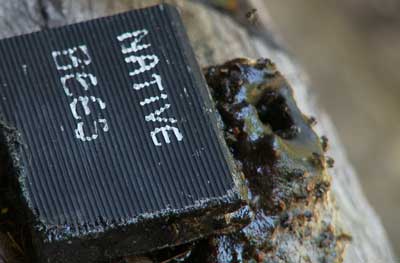Keeping Australian Native Stingless Bees
There are reported to be over 1600 varieties of bees in Australia but only 14 species are stingless. Australian stingless bees are a lot smaller and darker looking than your average sized honey bee. There’s one good advantage in being small, and that’s at being able to pollinate tiny delicate hard to reach blossoms.
That’s where the Australian Native Bees come into the picture.
Permaculture practitioner Anne Wensley has been keeping these bees for over 25 years. Generations of bees have inhabited the same log that sits outside her front door. Whilst we were filming a segment with Anne about her chickens when we spotted her bees in a log outside her door.
Watch the Youtube clip to see Anne show you her native bee hive.
[youtube]http://www.youtube.com/watch?v=Um5yPfKMybU[/youtube]
Native bees are scarce in some areas of Australia because of the practice of clearing and burning fallen timber.
These bees like to inhabit hollow tree logs. Keeping Native bees close to your home is an excellent way to pollinate Australian native plants and keep the bio-diversity of native plant species functioning.
Don’t expect to get the same volume of honey as European bees. A typical commercial honey bee hive will produce anything up to 75 Kilos of honey per year. The smaller native bees will only produce a small amount of honey, less than one kilo of honey per year. The taste will be more diverse than normal honey. People describe native honey as resin flavoured and more sweet and sour, with a hint of fruit. But the advantages of keeping the little native bees are numerous. They don’t sting. They aid in the pollination of a diversity of eucalypts, exotic plants as well as native fruit and nut trees such as macadamias and mango trees.
They are also a fascinating creature to watch.
They rarely leave their hive if the temperature is less than 18 decrees Celsius. Do face their hive at a North-East aspect, preferably a shaded spot in the garden with as few obstructions to their flight path as possible. Some varieties have problems coping at extreme temperatures. The best climate range for Native bees is around the 18 – 35 degrees Celsius mark. Over 40 degree temperatures with hives located in fierce sun can have a serious impact on the welfare of the hive.
Expect to see more on bee-keeping in the new Geoff Lawton Urban Permaculture DVD due later in the year.







Great Post 😀
thought you might like this machinima film i made on bees and permaculture
http://www.youtube.com/watch?v=CsVL22dIdKw
bright blessings
elf ~
Here’s another Machinima film with Geoff Lawton in it!
http://www.youtube.com/watch?v=44Ug8u6rI4g
Amazing stuff…Pretty Cosmic too! 🙂